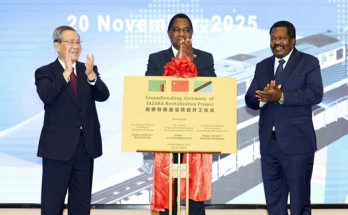 Recently, Quantum Global’s independent research arm, Quantum Global Research Lab launched the latest Africa Investment Index (AII) at the Movenpick Hotel in Accra Ghana. According to the report, Ghana is the eighteenth most attractive economy for investments flowing into the African continent. In 2016, the country attracted a net foreign direct investment of US$3.5 billion. However, the report revealed that the top five African investment destinations attracted an overall FDI of $13.6 billion. Botswana was ranked the most attractive economy for investments flowing into the African continent followed by Morocco, Egypt, South Africa and Zambia. Kenya and Nigeria ranked 15th and 19th respectively on the index.
Recently, Quantum Global’s independent research arm, Quantum Global Research Lab launched the latest Africa Investment Index (AII) at the Movenpick Hotel in Accra Ghana. According to the report, Ghana is the eighteenth most attractive economy for investments flowing into the African continent. In 2016, the country attracted a net foreign direct investment of US$3.5 billion. However, the report revealed that the top five African investment destinations attracted an overall FDI of $13.6 billion. Botswana was ranked the most attractive economy for investments flowing into the African continent followed by Morocco, Egypt, South Africa and Zambia. Kenya and Nigeria ranked 15th and 19th respectively on the index.
According to research by Quantum Global Research Lab (QGRL), Ghana’s economy has experienced strong and robust growth over the past decade, making its success a case worth emulating by its regional peers. Industry was the main driver of overall growth with an annual average growth of about 13 percent, followed by services with 8.4 percent and agriculture with about 8 percent. The strong growth record has fostered the country’s graduation to lower-middle-income status in 2010.
“Ghana’s democratic attributes are as robust as its economic growth, and by improving policies and institutions, successive governments have been able to build an attractive business climate conducive to growth. These measures include reducing the number of days it takes to register a limited liability company and days spent on resolving commercial disputes in the courts. Furthermore, the election of a new Government in 2016 has revitalised the drive for higher growth and infrastructure investment, all which augurs well for investment opportunities in the country,” said Prof Mthuli Ncube, Head of Quantum Global Research Lab.
What the research revealed about the Ghanaian Economy
According to the research, while the economy continued to grow at a steady pace until 2013, the GDP growth slowed from 7 percent in 2013 to 3.6 percent in 2016 due to structural challenges such as the ongoing fiscal deficits pushing public debt to over 70 percent of GDP, trapping the country in a cycle of debt service and borrowing.
Furthermore, a 3-year power crisis and power rationing slowed down private sector’s productivity and competitiveness. In addition, the significant external sector deficit and low world prices for the country’s gold, cocoa and oil export were a major factor behind the economic slowdown.
How did the Ghanaian financial sector fare?
According to the research, the financial sector in Ghana has undergone restructuring and transformation, and the supervisory framework is relatively strong. Bank credit to the private sector has increased, and capital markets are developing. The sector was rated as fairly developed by the 2014-2015 Global Competitiveness, with Ghana ranking 67th from 116th out of 148 countries.
This is how the Index was constructed
The Africa Investment Index (AII) is constructed from macroeconomic and financial indicators and the World Bank Group’s Ease of Doing Business Indicators (DBI). The DBI ranks countries in terms of a regulatory environment conducive to business operation. The AII focuses on six pillars or factors from a wider range of investment indicators, which include the share of domestic investment in the gross domestic product (GDP), the share of Africa’s total Foreign direct investment (FDI) net inflow, GDP growth rate forecast, population augmented GDP growth factor, real interest rate, the difference of broad money growth to the GDP growth rates, inflation differential, credit rating, import cover, the share of the country’s external debt in its Gross National Income (GNI), current account ratio, ease of doing business and the country’s population size. The AII indicators are based on secondary data collected from World Bank Development Indicators, the International Monetary Fund (IMF) World Economic Outlook, the United Nations Conference on Trade and Development (UNCTAD) Data Centre and own estimates.
The AII is a combination of individual indicator’s rank into a single numerical ranking. It averages the country’s macroeconomic and financial indicators rankings on the six different factors. Each indicator, and hence factors, receives an equal weight. Their rank score is then averaged to produce the total average score, which is consequently ranked from 1 to 54. The lower the value of the ranking, the better the implied business investment climate.
To produce an index score that captures medium-term changing aspects, individual country’s ranking is scaled relative to a benchmark or reference value (i.e., the past three year rolling average ranking). In addition to the intended measurement, this approach enables us to avoid periods of structural changes (which may compromise the index) that may be present in a longer time span, whether we consider a change from a reference average value or a historical reference period.



